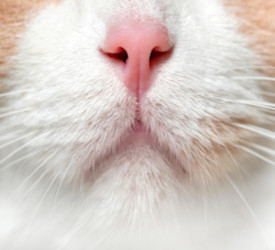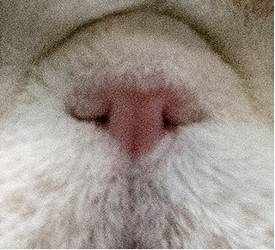
Brachycephalic Obstructive Airway Syndrome (BOAS) in cats
Overview
Symptoms
Risk
Diagnosis
Vet treatment
Home treatment
Prevention
When to worry

Brachycephalic Obstructive Airway Syndrome (BOAS) in cats
Brachycephalic Obstructive Airway Syndrome (BOAS) in cats refers to a group of conditions that result from abnormalities in the body. These are commonly found in flat-faced breeds of cats such as Persian, Himalayan and Exotic short-hair. The health problems seen in cats with brachycephalic syndrome are different from the ones seen in dogs.
BOAS can also be called brachycephalic respiratory syndrome. Brachycephalic cats have compacted skeletons that change the shape of their noses, throat, and other body parts. Breathing difficulties are the most common problems that can result from these abnormalities, compromising the health and welfare of the cat. As such, severely flat-faced cats should not be bred.

What is BOAS in a cat?
BOAS is a combination of signs that impair breathing seen in flat-faced (brachycephalic) breeds of cats.
BOAS is a common cause of upper airway obstruction in dogs, but less so in cats.
When present, it is a lifelong progressive disorder, meaning that it will get worse with time.
These anatomical changes that affect short-nose cats impair airflow through the upper airways (nose, mouth, voice box) and windpipe and contribute to persistent eye discharge.
Cats with brachycephalic syndrome may have:
Respiratory problems
Narrowed nostrils


Compacted nasal cavities and short nose
Bigger nasopharyngeal turbinates (ridges of bones in the nose covered by tissue)
Overlong soft palate
A tongue that is too big for their mouth, acting as an obstructive barrier to airflow
Narrow windpipe
Throat problems
Eye problems
Protruding eyes with reduced lid closure
Persistent eye discharge due to blocked tear ducts
Dental/mouth problems
Teeth are not aligned properly when the jaws are closed, leading to dental disease
Excessive skin
Excessive skin folds on the face contribute to narrower nostrils and make them prone to skin infections
The symptoms of BOAS can be subtle, but the condition can be very serious.
It is very important that you discuss the severity of your cat’s facial conformation and any symptoms that you have noticed with a vet.
Symptoms of BOAS in cats
The signs of BOAS are varied and can range in severity, including some or all of the following:
Difficulty breathing
Loud, raspy respiratory sounds
Snorting
Snoring
Nasal discharge
Worsening signs in hot or humid weather
Eye discharge
Are some cats more at risk of BOAS than others?
Breathing problems are very stressful, and things that appear minor may cause serious issues in the long term. The main risk factors are:
Being a brachycephalic breed: Persian, Himalayan, British Short-Hair and Exotic Short-Hair.
The severity of the physical defects
Being overweight
Older age

How will my vet know if my cat has BOAS?
Your vet will assess your cat’s facial shape and behaviour in certain circumstances. They will also carry out:
Physical and visual examination. There are measurements that can be taken of the nose and face, and have been shown to predict which cats are likely to develop severe disease in the future.
Throat examination under sedation or anaesthesia.
Rhinoscopy (exam of the inside of the nose).
X-rays and/or CT scans.
What treatment options are available for BOAS in cats?
The main treatments include weight control and surgery.
Will your cat need BOAS surgery?
Surgical procedures can include:
Widening of the nostrils
Reducing the length of the soft palate
Removing excessive and/or everted laryngeal tissue
Your veterinarian might recommend one or more of the above, based on your cat’s specific needs. In some cases, referral to a board-certified surgeon is recommended.
Even with surgery, brachycephalic animals’ airways will never be completely normal.
Are there any medical treatment options for cats with BOAS?
Weight control
Medication to reduce inflammation
Antibiotics to treat secondary respiratory infections
How to help your cat with BOAS at home?
Keep your cat slim: Monitor their food and body condition score (BCS). Carrying extra weight will make any breathing problems worse.
During hot/humid weather: Keep your cat indoors with air conditioning, when possible, and restrict exercise.
Reduce any respiratory irritants in the home, such as smoke, dust, mould and potentially air fresheners.
Reduce stress: Cats are very sensitive to stress, which can lead to a worsening of their BOAS signs.
What is the overall outlook for your cat?
The prognosis for cats with BOAS depends on how many physical problems are present and how old your cat is at the time of diagnosis and treatment. To maintain quality of life, vet visits should be done regularly to monitor new symptoms or to see if any worsen.
How can you prevent or minimize the signs of BOAS in cats?
Responsible breeding: cats with significant breathing difficulty or those that need surgery should not be used for breeding. It is usually recommended that these animals be neutered at the same time that surgical correction is performed.
Ongoing care: to reduce the severity and frequency of BOAS symptoms follow the previous recommendations on diet, exercise, and environmental modifications.
When to worry if your cat has BOAS?
Seek immediate assistance from an emergency vet practice if your cat:
Struggles to breathe or is open-mouth breathing (cats do not pant, this may be an emergency)
Gums become blue or grey
Collapses
At Joii we can help:
If you are thinking about getting a flat-faced breed cat
Assess your cat’s weight or help them lose it
Check if your cat has any symptoms of BOAS

















